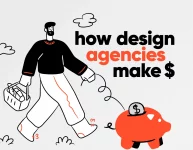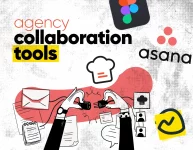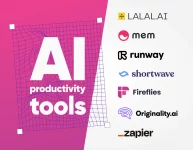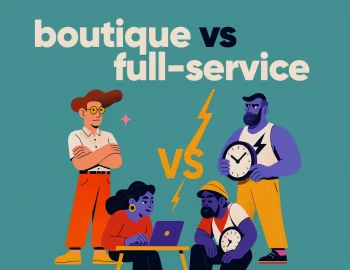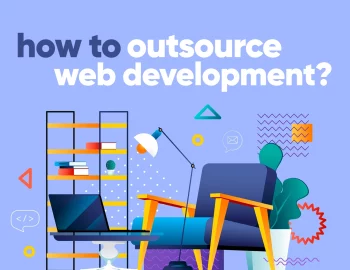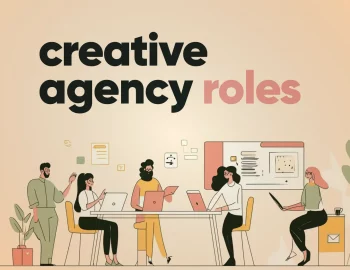If you’ve been a freelancing creative for a while, you’ve probably heard agencies being addressed as a “studio,” “boutique,” “collective,” or “full-service”, but what do these business models actually mean? And how do you structure something like that?
Picking the right business model isn’t just a matter of vibes – it affects everything, from your pricing to your team setup to the kind of clients you attract. That’s why today, I’ll break down for you the most common business models so you can find the right fit and build a sustainable and exciting creative agency.
We’ll go through the business models creative agencies typically use and two new ones rapidly gaining popularity in 2025. I’ll also help you understand the various pricing structures and how they work within the different business models, and I’ll share with you real-world examples of freelancers who have successfully transitioned to digital agency owners.
The core creative agency business models (and what they look like in 2025)
As you start thinking about how to structure your agency, it helps to understand that there isn’t such a thing as the best agency business model that also works for everyone. The best one for you depends on your goals, your team, and how you like to work. So, let’s dive deeper and see what the different business models have to offer!
1. The Boutique Agency
What it is: This model is all about being small, specialized, and strategic. A boutique agency typically focuses on a specific niche or creative offering, like brand identity for wellness brands or UI/UX design for SaaS startups, for example.
You’re not trying to be everything to everyone; you’re instead going deep, not wide, making it ideal for targeting clients who want personalized service, care about aesthetics and strategy, and prefer working closely with a small, senior team.
- High creative control
- Easier to charge premium prices
Cons:
- Capacity is limited by team size
- May need strong boundaries to avoid scope creep
Team setup & revenue model: Typically 2-5 people, often a core duo or trio (designer, project manager, developer). Revenue usually comes from fixed project rates or value-based pricing models.
2. The Creative Studio
What it is: A creative studio leans hard into the craft. While it may overlap with boutique agencies, studios are often more execution-focused – branding, packaging, illustration, motion, or visual content.
These are often founder-led, portfolio-driven, and can sometimes feel like “designer passion projects that became businesses.” The studio business model is ideal for clients who already have a strategy and just need execution, are rebranding or launching a product, or are drawn to distinctive, elevated visual work.
- High-quality creative work
- Great for attracting cool, creative clients
Cons:
- It may be undervalued if a strategy isn’t included
- Clients might treat it more like a “vendor” than a partner
Team setup & revenue model: In this lean and agile model, the team is often just the founder and a few creative contractors. Pricing may be project-based or retainer (if content creation is ongoing).
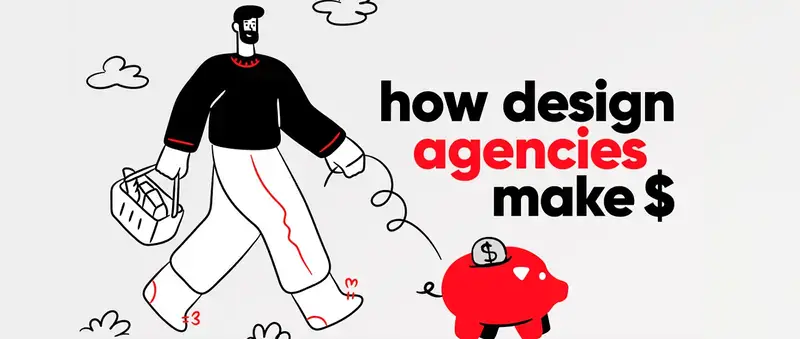
3. The Collective Model
What it is: A flexible, decentralized model where you, as the founder, are the core, and you bring in trusted collaborators per project. This is a great transitional step from freelancing because it mirrors how many freelancers already work: with a network of developers, writers, marketers, and strategists.
It’s great when your target market is people who like the idea of a small team tailored to their project, want senior-level talent without big-agency fluff, and are open to a distributed and remote-first setup.
- Low overhead and high flexibility
- Easy to scale up or down
Cons:
- It can be harder to create a consistent brand experience
- Project management can get messy without clear systems
Team setup & revenue model: You’re the lead, client-facing, managing the work, and doing some of it too, while others are brought in as needed. Revenue is usually split per project or role.
4. The Full-Service Agency
What it is: This is the “we do it all” model – branding, design, development, copywriting, marketing, strategy, and sometimes even paid media or SEO. Full-service agencies are built to handle every stage of the client journey, offering one unified experience across disciplines.
All this makes it a suitable model for targeting clients who want to squeeze all creative work under one roof, are launching a new brand or going through a major rebrand, and expect strategic input across disciplines.
- Great for attracting high-budget, retainer-friendly clients
- More control over the outcome since everything’s in-house
Cons:
- Higher overhead and management complexity
- Requires stronger processes to keep everyone aligned
Team setup & revenue model: Usually 5+ people, a mix of full-time and long-term contractors. Here, project manager roles become essential as the team grows, while the agency’s profitability comes from large flat-rate projects or monthly retainers.
5. The Hybrid Model
What it is: This one’s a mix – it’s flexible, adaptive, and built to match your strengths while expanding your offerings through partnerships. Maybe your agency does branding in-house, but hires a performance marketing agency for ongoing campaigns, or you do websites and partner with a copywriter on the side, for example.
It’s good for attracting clients who need a mix of specialized services, are okay with some parts being handled by external partners, and want a curated experience but without the big-agency feel.
- You stay focused on your zone of genius
- More offerings without more full-time hires
Cons:
- Client experience can feel disjointed if not well-managed
- More communication is needed across teams/partners
Team setup & revenue model: A small core team plus a go-to network of creative partners. Revenue is split or marked up based on scope, yet hybrid agencies can also offer tiered packages depending on how much is handled in-house.
6. The Productized Service Agency
What it is: In this model, services are packaged like products: clear project scopes, fixed timelines, and transparent pricing. Think “Brand Identity in 2 Weeks” or “Webflow Site for $4K.”, for example. It’s all about efficiency, predictability, and coming up with a value proposition that makes it easy for clients to say yes.
Suitable for clients that are early-stage businesses that want to move fast, appreciate structure and clear deliverables, and want high-quality work but without the custom-agency price tag.
- Easy to scale and delegate
- Eliminates endless proposals and pricing conversations
Cons:
- Not ideal for complex or bespoke projects
- Requires very strong systems and boundaries
Team setup & revenue model: Tight team with defined roles – designer, developer, maybe a strategist. Revenue is project-based but highly optimized and often leads to recurring revenue products (like templates, add-ons, or upgrades).
7. The Micro Agency
What it is: Small but mighty, the micro agency business model is all about staying lean and efficient while delivering polished, professional work. Think 2-4 people agency staff max, all wearing multiple hats but with clear roles. It’s ideal for folks who want to scale just enough to stop soloing – but not so much that they lose creative control or freedom.
Useful when targeting audiences who want senior-level talent on their project, appreciate a personal, tight-knit team, and have mid-sized budgets and clear deliverables.
- Low overhead, high trust
- Easy to manage and stay profitable
Cons:
- Capacity is limited, and burnout can creep in
- Losing one team member can bottleneck everything
Team setup & revenue model: A crew of 2-4 core people, often all senior-level. Revenue comes from fixed project pricing, occasionally supplemented by retainer work for repeat clients.
Bonus: Emerging business models for creative agencies in 2025
The creative world is a dynamic industry, and things are moving fast. With AI tools, digital products, and changing client behavior, a new wave of agency models is bubbling up. They might not be mainstream yet, but they’re already gaining traction, especially for folks who want to do things differently.
8. The AI-Integrated Agency
This model weaves AI directly into the workflow, not to replace creatives, but to enhance them. From AI-assisted copywriting and image generation to automation in research, content production, and even brand strategy, these agency owners embrace tech to move faster and deliver exceptional results smartly.
- Why it’s rising: Tools like ChatGPT, Midjourney, and Runway are getting scary-good. Agencies that know how to use them responsibly can lower costs, shorten timelines, and offer hybrid human-AI services that are still rooted in creative direction.
- Ideal for: Agencies serving tech-forward or budget-conscious clients; Designers who enjoy experimenting with new tools; Founders looking to productize or speed up delivery.
9. The Education-First Agency
This business model blends creative agency services with teaching. The agency still does creative work, but it also creates content, runs workshops, does consulting services, and sells courses or templates. It’s half service, half platform – serving clients and building community.
- Why it’s rising: There’s a growing appetite for creative leadership, not just deliverables. People want to learn from agencies they trust. Meanwhile, for the agency, it’s a brilliant way to build authority, diversify income, and attract inbound leads.
- Ideal for: Creatives who love sharing knowledge; Digital agencies wanting to scale but without hiring more staff; Founders, building a personal brand alongside their agency.
Pricing models for creative agencies
Let’s talk about money, because how you price your services is just as foundational as what you offer. The pricing model you choose doesn’t just affect your cash flow, it shapes your client relationships, team structure, and even your growth trajectory. So, what are your options?
1. Hourly Rate
How it works: You charge clients based on the time tracked working on the project, usually in increments (for example, $100/hour).
Best for: Freelancers, hybrid setups, or project overflow work.
- Easy to set up
- Familiar to clients
- Good for open-ended work
Cons:
- Caps your income at your time limit
- Encourages micromanagement
- Hard to scale with a team
Where it fits: It works well when implemented short-term in Collective, Studio, or Hybrid models, but it’s not ideal for long-term agency growth.
2. Flat Project Fee (Project-based model)
How it works: You scope out a project and charge a fixed amount for the entire deliverable.
Best for: Agencies with defined service packages or repeatable deliverables.
- Predictable for both sides
- Encourages efficiency
- Easier to sell when your value is clear
Cons:
- Risk of underestimating time
- Scope creep danger
- Can underpay your team if miscalculated
Where it fits: A Fixed fee is a good fit for Boutique, Studio, or Full-Service Agencies.
3. Retainer model (Monthly Package)
How it works: Clients pay a recurring monthly fee for ongoing work (for example, design or web support, strategy, social media management, content creation, updates).
Best for: Creative agencies looking to stabilize income and create long-term client relationships.
- Predictable revenue
- Builds long-term partnerships
- Easier to plan capacity
Cons:
- Harder to sell to newer clients
- Requires a clear scope to avoid burnout
- It can feel like employment if boundaries aren’t clear
Where it fits: Collective, Micro Agency, Full-Service, and also thrives in Hybrid and Productized models with set deliverables.
4. Value-Based Pricing
How it works: The client pays based on the outcome or business impact your work delivers, not the hours you put in or the deliverables.
Best for: Strategic, high-trust client relationships
- Unlocks higher profit potential
- Focuses on impact over input
- Attracts premium clients
Cons:
- Requires strong sales and positioning
- Not all clients understand or trust it
- Harder to estimate without experience
Where it fits: Works best with Boutique and Education-First Agencies or when paired with custom scopes.
5. Productized Pricing
How it works: You offer clearly defined services at fixed prices (like a menu), but no custom proposals or hourly breakdowns.
Best for: Agencies that want scale, efficiency, and reduced friction in sales.
- Easy to sell and repeat
- Great for async clients and small teams
- Streamlined delivery process
Cons:
- Can feel stiff for complex client demands
- Takes time to systematize properly
- You need volume to grow it
Where it fits: Productized Service, AI-Integrated, and Education-First Models, and also useful as an add-on revenue stream in Hybrid setups.
6. Commission or Performance-Based
How it works: You charge based on the results you deliver, something measurable, like lead generation or revenue increase, for example.
Best for: Agencies working in growth marketing, sales funnels, or conversion optimization.
- High motivation alignment
- Can bring in big wins and long-term trust
- Unique positioning angle
Cons:
- Risky if you don’t control the outcome
- Can lead to stressful client dynamics
- Requires tight, well-defined contracts
Where it fits: Growth-Focused Collectives or AI-Powered Models working with ROI-based deliverables.
So, what pricing structure should you use?
You don’t have to pick just one model – many digital agencies run by blending pricing types depending on the client, project, or phase. Here’s a quick cheat sheet:
| Business Model Type | Best Pricing Model Fits |
|---|---|
| Boutique | Flat Fee, Value-Based, Retainer |
| Creative Studio | Flat Fee, Retainer |
| The Collective Model Agency | Hourly, Flat Fee, Retainer |
| Full-Service Agency | Flat Fee, Retainer, Value-Based |
| Hybrid Model | Hourly, Flat Fee, Retainer |
| Productized Service Agency | Productized Pricing + Fee from custom work, Subscription Retainers |
| Micro Agency | Project-Based, Retainer |
| AI-Integrated Agency | Productized, Retainers, Performance-Based |
| Education-First Agency | Productized + Flat Fee for Custom Work |
Real-world examples of freelancers who transitioned to creative agency owners
Now I can’t wait to share with you these examples of people who have thoughtfully chosen their business models and successfully built their agencies, inspiring everyone on the same creative path:
1. Designjoy
Founder: Brett Williams
From: Freelancer
To: One-person agency using a productized subscription model
What’s cool about it: Brett Williams made waves by offering unlimited design through a flat-rate subscription and thus scaled to $1M+ solo. He used processes, automation, and clear boundaries to manage a high volume of work without hiring.
To this day, he still operates alone, a jack of all trades that has found the perfect business and pricing models for his strengths and skills. With his journey, Brett proves that assessing honestly what we have to offer and advertising it the right way can lead to great success and happier (and returning) clients.
2. The Creative Exchange
Founder: Anna Sullivan
From: Freelance social media consultant
To: Founder and CEO of The Creative Exchange, a full-service social media agency
What’s cool about it: Anna began her marketing journey during her undergraduate studies at the University of North Carolina, Greensboro. She freelanced for startups and marketing agencies, working with brands such as Health-Ade Kombucha, Southwest Airlines, and Four Seasons Hotels. Her proactive approach to networking and volunteering led to significant opportunities, including a role at an agency where she worked with major clients.
Anna transitioned from solo freelancing to building a team, evolving from part-time freelancers to a mix of full-time and part-time roles. Thus, Anna’s story serves as a testament to the power of initiative, adaptability, and the importance of building genuine connections in the industry.
3. The Studio Temporary
Founder: Scott Fuller
From: Freelance designer and regular employee
To: Boutique design studio specializing in branding and identity
What’s cool about it: Scott built a clean, recognizable brand and surrounded himself with a small but mighty team. The Studio Temporary works with a range of clients (from nonprofits to Fortune 500s) without growing into a massive operation. Their design-first, craft-driven vibe proves you can stay boutique and still be taken seriously by big clients.
Focusing on quality, positioning, and collaboration, while using design as a sales tool, Scott is a living example of how to evolve into a tightly run, successful studio.
Bottom line
At the end of the day, your creative agency’s business model is just that – a model. A starting point. A structure to help you build something that supports your vision, your values, and your lifestyle. There’s no single “right” path – only the one that aligns with how you want to grow. You might even blend elements from multiple models as you evolve (and that’s more common than you think).
Start where you are, stay curious, and certainly don’t be afraid to experiment. Every successful agency you admire once stood where you’re standing now: full of questions, figuring it out one move at a time. You’ve got this!
Oh, wait, if you want to level up your knowledge even further, here are a few other articles that might help:


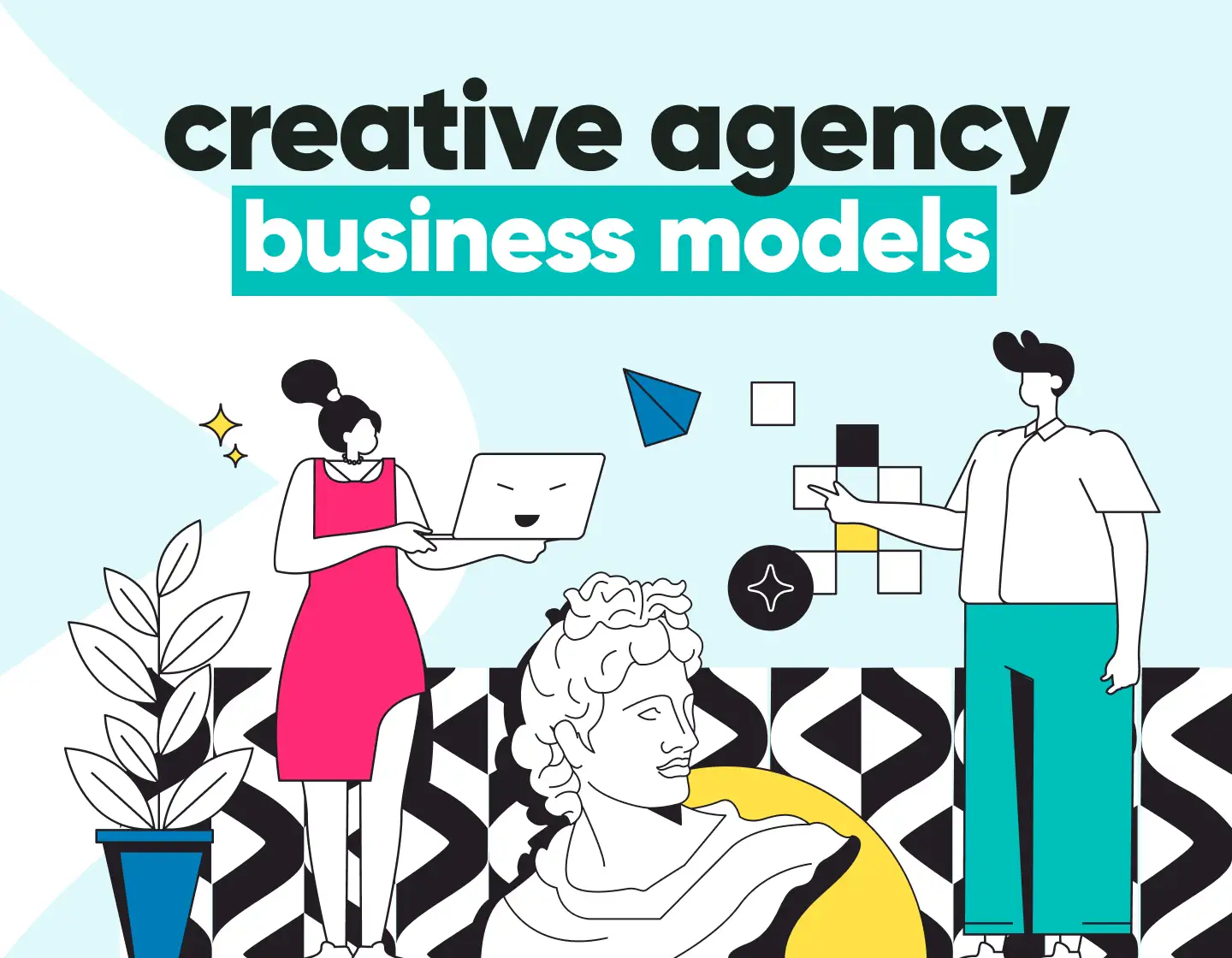
![15 Tips for Effective Communication With Clients [That Actually Work]](https://reallygooddesigns.com/wp-content/uploads/2025/04/tips_for_effective_communication_with_clients-193x150.webp)
